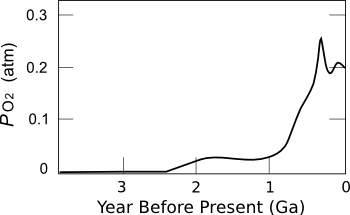
Early Oxygen
September 17, 2014 We owe our oxygen-fueled existence to Earth's many photosynthetic plants and bacteria. Oxygen exists presently in Earth's atmosphere at a partial pressure of about 0.21 atmospheres, but there was a time when the pressure was nearly zero. It's understandable that scientists are interested in when our atmosphere started to become oxygen-enriched, since that would mark the time when such life first evolved on our planet. The history of Earth's oxygen is contained in its geological record. As I wrote in a previous article (Ordovician Carbon Sinks, February 28, 2012), oxygen-producing organisms weren't present on land until about 450 million years ago, during the Ordovician period. These early land plants were primitive, non-vascular mosses. They likely evolved from green algae in the oceans, but the oceans were teeming with oxygen-producing prokaryote cyanobacteria long before then. Cyanobacteria are thought to have appeared about 2.5 billion years ago, but the oxygen that they produced chemically combined with iron and organic compounds. Since the seas that time were acidic, there would have been large quantities of dissolved iron, and some nickel. Oxygen produced by the cyanobacteria would have combined with iron to form iron oxide. One record of this is the appearance of iron bands in Archean sedimentary rocks (see photograph). | A black-banded ironstone, about 2.1 billion years old, at the National Museum of Mineralogy and Geology in Dresden, Germany. Iron oxide was precipitated in the oceans until the dissolved iron was gone. (Detail of a photo by André Karwath, via Wikimedia Commons.) |
 | Estimated oxygen content of Earth's atmosphere over the ages. Earth's oxygen partial pressure is now about 0.21 atmospheres. (Figure by Heinrich D. Holland, modified, via Wikimedia Commons.) |
"This is a very exciting finding, which helps to fill a gap in our knowledge about the evolution of the early Earth. This paleosol from India is telling us that there was a short-lived pulse of atmospheric oxygenation and this occurred considerably earlier than previously envisaged."[2]
 | A hand sample of 3.02 billion year old palaeosol, formed long before the Great Oxygenation Event. (Photograph by Quentin Crowley.)[2] |
References:
- Joydip Mukhopadhyay, Quentin G. Crowley, Sampa Ghosh, Gautam Ghosh, Kalyan Chakrabarti, Brundaban Misra, Kyle Heron, and Sankar Bose, "Oxygenation of the Archean atmosphere: New paleosol constraints from eastern India," Geology, vol. 42, no. 10 (October 2014), pp. 1–4.
- Trinity geologists re-write Earth's evolutionary history books, Trinity College Dublin Press Release, September 4, 2014.